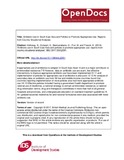Antibiotic Use in South East Asia and Policies to Promote Appropriate Use: Reports from Country Situational Analyses
| dc.contributor.author | Holloway, Kathleen Anne | |
| dc.contributor.author | Kotwani, Anita | |
| dc.contributor.author | Batmanabane, Gitanjali | |
| dc.contributor.author | Puri, Monika | |
| dc.contributor.author | Tisocki, Klara | |
| dc.date.accessioned | 2018-10-08T09:01:35Z | |
| dc.date.available | 2018-10-08T09:01:35Z | |
| dc.date.issued | 2018 | |
| dc.identifier.citation | Holloway, K.; Kotwani, A.; Batmanabane, G.; Puri, M. and Tisocki, K. (2018) 'Antibiotic use in South East Asia and policies to promote appropriate use: reports from country situational analyses', BMJ 2017;358:j2291 | en |
| dc.identifier.uri | https://opendocs.ids.ac.uk/opendocs/handle/20.500.12413/14083 | |
| dc.description.abstract | Inappropriate use of antibiotics is rampant in South East Asia1-6 and is a major contributor to antimicrobial resistance.7-9 However, data on antibiotic use are scant, few effective interventions to improve appropriate antibiotic use have been implemented,10 11 and implementation of policies for appropriate use of antibiotics is also poor.12 13 An analysis of secondary data on antibiotic use from 56 low and middle income countries found that countries reporting implementation of more policies also had more appropriate antibiotic use.14 15 Effective policies included having a government health department to promote rational use of medicines, a national strategy to contain antimicrobial resistance, a national drug information centre, drug and therapeutic committees in more than half of all general hospitals and provinces, and undergraduate education on standard treatment guidelines.15 An updated essential medicines list and national formularies were also associated with lower antibiotic use. | en |
| dc.language.iso | en | en |
| dc.publisher | 2018 BMJ Publishing Group Ltd. | en |
| dc.rights | This an open access article distributed under the terms of the Creative Commons Attribution-non-commercial IGO License https://creativecommons.org/licenses/by-nc/3.0/igo/), which permits use, distribution, and reproduction for non-commercial purposes in any medium, provided the original work is properly cited. In any reproduction of this article there should not be any suggestion that WHO or this article endorse any specific organisation or products. The use of the WHO logo is not permitted. This notice should be preserved along with the article’s original URL. | en |
| dc.rights.uri | https://creativecommons.org/licenses/by-nc/3.0/igo/ | en |
| dc.subject | Health | en |
| dc.title | Antibiotic Use in South East Asia and Policies to Promote Appropriate Use: Reports from Country Situational Analyses | en |
| dc.type | Article | en |
| dc.rights.holder | Copyright © 2017, British Medical Journal Publishing Group | en |
| dc.identifier.externaluri | https://www.bmj.com/content/358/bmj.j2291 | en |
| dc.identifier.doi | dx.doi.org/10.1136/bmj.j2291 | |
| rioxxterms.funder | Default funder | en |
| rioxxterms.identifier.project | Default project | en |
| rioxxterms.version | VoR | en |
| rioxxterms.versionofrecord | http://dx.doi.org/10.1136/bmj.j2291 | en |
| rioxxterms.funder.project | 9ce4e4dc-26e9-4d78-96e9-15e4dcac0642 | en |
Files in this item
This item appears in the following Collection(s)
-
Journal Articles - External [429]
-
IDS Research [1671]
Except where otherwise noted, this item's license is described as This an open access article distributed under the terms of the Creative Commons Attribution-non-commercial IGO License https://creativecommons.org/licenses/by-nc/3.0/igo/), which permits use, distribution, and reproduction for non-commercial purposes in any medium, provided the original work is properly cited. In any reproduction of this article there should not be any suggestion that WHO or this article endorse any specific organisation or products. The use of the WHO logo is not permitted. This notice should be preserved along with the article’s original URL.


